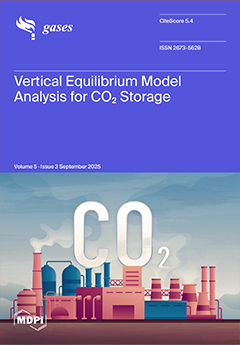This work examines how multiphase flow behavior during CO
2 and N
2 displacement in a microfluidic chip under capillary-dominated circumstances is affected by interfacial tension (IFT) and the viscosity ratio. In order to simulate real pore-scale displacement operations, microfluidic tests were performed
[...] Read more.
This work examines how multiphase flow behavior during CO
2 and N
2 displacement in a microfluidic chip under capillary-dominated circumstances is affected by interfacial tension (IFT) and the viscosity ratio. In order to simulate real pore-scale displacement operations, microfluidic tests were performed on a 2D rock chip at flow rates of 1, 10, and 100 μL/min (displacement of water by N
2/supercritical CO
2). Moreover, core flooding experiments were performed on various sandstone samples collected from three different geological basins in Australia. Although CO
2 is notably denser and more viscous than N
2, the findings show that its displacement efficiency is more influenced by the IFT values. Low water recovery in CO
2 is the result of non-uniform displacement that results from a high mobility ratio and low IFT; this traps remaining water in smaller pores via snap-off mechanisms. However, due to the blebbing effect, N
2 injection enhances the dissociation of water clots, resulting in a greater swept area and fewer remaining water clusters. The morphological investigation of the residual water indicates various displacement patterns; CO
2 leaves more retained water in irregular shapes, while N
2 enables more uniform displacement. These results confirm earlier studies and suggest that IFT has a crucial role in fluid displacement proficiency in capillary-dominated flows, particularly at low flow rates. This study emphasizes the crucial role of IFT in improving water recovery through optimizing the CO
2 flooding process.
Full article




